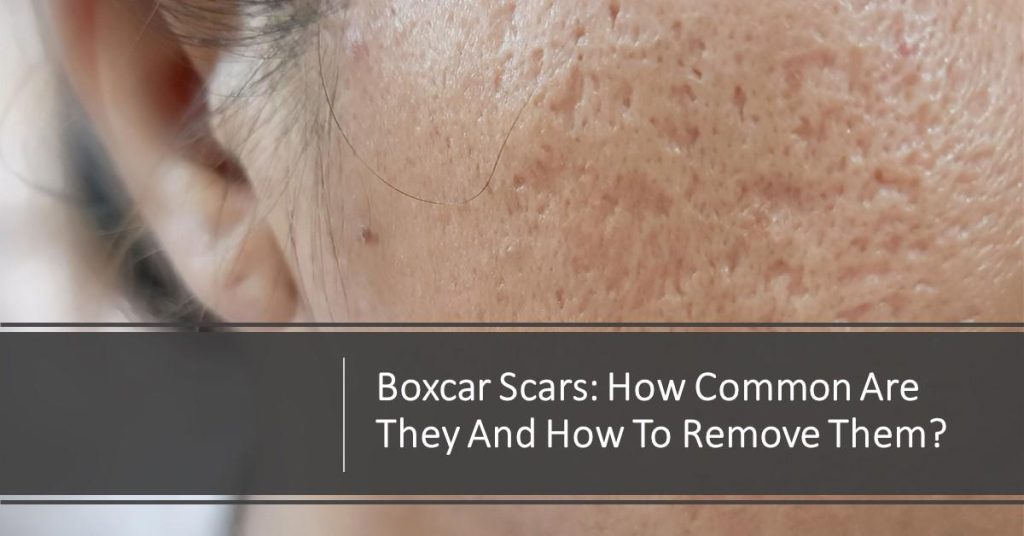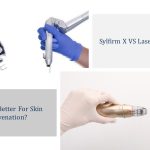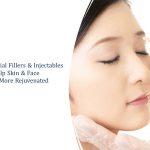What Are Boxcar Scars?
Boxcar Scars are specific forms of scars, which are round or oval in shape and cause the skin that they affect to appear depressed. These are usually seen after some forms of acne heal. Their colour may vary from red to dark brown. However, some Boxcar scars may also be the same colour as the individual’s skin tone.
Moreover, these scars are atrophic in nature. This means the skin is not able to regenerate on its own and return to its previous healthy state. Experts are still trying to figure out how some individuals are at a greater risk for Boxcar scars while others appear to be protected. For example, some individuals may get severe Boxcar scarring after only mild acne; others may come with more severe acne and not get any scarring.
What Causes Boxcar Scars?
The Boxcar scars, just like any other form of scarring it caused by trauma to the skin surface. In order to overcome this trauma, the skin usually tries to heal itself and produce collagen fibres to help it return back to its original healthy state.
However, sometimes this is not possible. When the skin is not able to produce enough collagen for its healing, it leads to pitting or depression in the affected area of the skin. The type of trigger or skin injury that most commonly causes Boxcar Scars are acne breakouts and chicken pox.
Acne Breakout
Acne is a type of skin condition that occurs as the hair follicles in the skin become blocked with debris, dead cells and oil. This leads to the formation of whiteheads, blackheads and pimples on the affected skin surface. While it most commonly occurs in the teenage population, some adults may also experience it. Moreover, the type of acne that is most commonly associated with Boxcar Scars is nodular or cystic acne. This includes hard and painful cysts being formed under the skin’s surface.
Chicken Pox
Chicken pox is another common cause of the appearance of Boxcar Scars in the population. This is an infectious and contagious condition, which is caused by the virus known as Varicella Zoster Virus. Chickenpox most commonly affects children, but it may also be seen in the adult population. Individuals affected by chicken pox have red blisters on their skin, which take some time to heal. The skin has to work harder to replace the collagen lost due to these blisters, and sometimes it cannot do this. This eventually causes the formation of dents and depression in the skin.
What Are The Risk Factors For Boxcar Scars?
The factors which may put an individual more at risk for Boxcar scars include:
- Having nodules or cysts due to inflammatory conditions of the skin
- Having acne vulgaris for a long time that has not been treated
- Popping a pimple before it has healed
- A family history of severe acne and associated scarring
Other Types of Atrophic Scars
While Boxcar Scars are a common form of atrophic scars, other types exist as well. These include the Icepick Scars and Rolling Scars.
Icepick Scars
Ice pick scars are another common type of atrophic scarring that may result from acne. As the name suggests, the icepick scars appear as sharp and small indentations on the skin. They are wider at the surface of the skin and get narrower into the skin surface – resembling an ice pick. While the majority of these scars are small in size, some individuals may have icepick scars that are bigger in size as well. Hence the size of these scars is seen to vary from individual to individual based on their skin condition and the trauma that caused their formation in the first place.
Moreover, these scars are more commonly seen in areas of the body where the skin is thinner and less commonly in the areas where the skin is thicker. The common areas of the face where icepick scars may be seen include the forehead and skin lying over the cheekbones.
Rolling Scars
Rolling scars are a unique type of atrophic scars which are formed due to a band of scar tissue being formed under the surface of the skin. This band of scar tissues gives the skin overlying it an uneven appearance. The size of this scar may vary from individual to individual; in the majority of cases, the rolling scars are between 4 to 5 millimetres wide.
How Do Scars Develop?
Scars are developed as a result of the body’s natural healing processes after it has been exposed to an injury or trauma. When the skin is damaged, due to any reason, it causes the tissues to be affected and collagen to get released. The collagen fibres start to build up in the area of the skin which has been damaged in an attempt to strengthen the wound and heal the skin. The formation of new collagen in the affected area continues for many weeks, which also causes the blood supply to increase. This continued build-up of collagen and increase in blood supply causes the skin to become lumpy and uneven – forming a scar.
How to Avoid Getting Boxcar Scars?
One of the most recommended ways to prevent the formation of Boxcar scars is to get proper treatment for cystic acne as early as possible. If cystic acne is left untreated, it is more likely to heal through scarring. While treatment may not be needed for all forms of acne, certain forms, like cystic and nodular acne, may require proper medical treatment. For others, only over-the-counter medications may be enough. However, in the case of cystic and nodular acne, the nodule and cysts are present under the surface of the skin. Hence the ointments and topical treatment available over the counter may not be enough to treat it. Hence, to target such a form of acne, the doctor may recommend certain prescription medications with a high enough strength to dry the cysts. They may also be recommended to use vitamin A derivatives or retinoids to unclog the hair follicles and prevent the formation of acne.
Can Boxcar Scar Fade on Its Own?
The Boxcar scars usually don’t go away on their own. Instead, they often require medical treatments to effectively remove them from the skin and allow the skin to return back to its previous form.
Boxcar Scar Treatment Options
Popular Boxcar Scar Treatments include TCA Cross, Laser Resurfacing, Subcision and Dermal Fillers.
TCA Cross
TCA stands for trichloroacetic acid, which is a type of chemical agent often incorporated in skin peels. TCA Cross is a procedure when the trichloroacetic acid is directly placed on the scars, allowing chemical reconstruction. This method was originally introduced by a Korean doctor many years ago. While it is popularly known for its ability to treat Boxcar scars, it may also be used for other forms of atrophic scarring, like icepick scars. The TCA concentration is between 70% to 100%, which is high enough to promote elastin and collagen formation in the skin. Therefore, effective results can be obtained after only 3 to 5 treatments of TCA cross; however, these treatment sessions are conducted with a gap of at least six weeks in between.
Laser Resurfacing
Two forms of laser resurfacing techniques may be used for treating mild to moderate skin scarring. These include Ablative and non-ablative laser treatment. The ablative laser treatment involves the removal of a small patch of skin around the scar to promote the formation of new smoother skin. On the other hand, the non-ablative treatment stimulates collagen production in the affected skin without removing any patch of skin.
Subcision
Subcision is a technique to separate the skin’s top layer from the underlying scar tissue. This is done using a needle inserted under the skin’s surface and moves in numerous directions. The movement of the needle under the skin and separation of the scar tissue starts a healing process, pushing the scar tissue upwards. However, subcision is not commonly used for the treatment of Boxcar scars.
Dermal Fillers
Dermal fillers may also be used to correct the appearance of the depression or pitting caused by the boxcar scars. These fillers can be temporary, semi-permanent or permanent. While the body can remove temporary and semi-permanent fillers, permanent fillers are non-biodegradable. The injection of dermal fillers can improve uneven skin and the appearance of scarring. Fillers that are found to be particularly effective for this purpose are hyaluronic acid fillers, as they stimulate collagen production.
How Long Until Boxcar Scar Treatments Work?
The longevity of the Boxcar Scars depends on a number of factors which include:
- Depth of Scarring
- Skin Condition
- Age of the scar
Generally, the Boxcar treatment in young individuals with recent shallower scars and healthy skin is able to demonstrate much more effective and quicker results than individuals with older and deeper scars.
Final Thoughts
Boxcar scars are commonly formed after acne formation or chicken pox. These scars may be prevented by early treatment of acne through consultation with a health professional. However, once these scars are formed, they may be treated with methods like TCA cross, Laser Resurfacing, Subcision and dermal fillers.
About Dream Aesthetics and Plastic Surgery
Bespoke surgical for cosmetic or medical reasons is what Dream covers to bring out the beauty in every individual. Going beyond the aesthetics and working on physical anomalies are what we value the most in leading our patients to cherish self-improvement and confident lifestyles.
Derived from Associate Professor Vincent Yeow’s long-standing experience performing plastic surgery in Singapore, our treatment plans deliver physical remodelling in our patients’ favour. One of the notable remodellings is droopy eyelid correction. The ptosis surgery used for treatment eventually fixes drooping eyelids, improves vision and enhances appearance.
Most importantly, as a trustworthy plastic surgery and aesthetic clinic, we treasure positive and natural outcomes for each individual. We will ensure to deliver the beauty refinement of your dream without compromising your safety and privacy.







